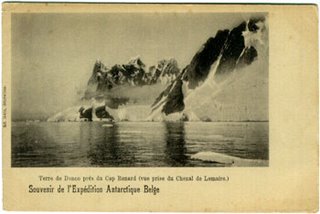 ‘Polar stratospheric clouds’ formed last week when temperatures dropped below 176 degrees Fahrenheit. According to Renae Baker, a meteorological officer with the Australian Bureau of Meteorology at Mawson, Antarctica and who took the pictures on July 25, 2006, “Delicate colours produced when the fading light at sunset passed through tiny water-ice crystals blown along on a strong jet of stratospheric air.”
‘Polar stratospheric clouds’ formed last week when temperatures dropped below 176 degrees Fahrenheit. According to Renae Baker, a meteorological officer with the Australian Bureau of Meteorology at Mawson, Antarctica and who took the pictures on July 25, 2006, “Delicate colours produced when the fading light at sunset passed through tiny water-ice crystals blown along on a strong jet of stratospheric air.” 
These kinds of clouds only occur at high polar latitudes and in winter. A weather balloon put temperatures at -189 degrees that day. “Amazingly, the winds at this height were blowing at nearly 230 kilometers (143 miles) per hour,” Baker said.
 http://news.yahoo.com/s/ap/20060801/ap_on_sc/antarctica_clouds_
http://news.yahoo.com/s/ap/20060801/ap_on_sc/antarctica_clouds_http://www.aad.gov.au/default.asp?casid=23042
It was during the Victorian Era, a time of great exploration and invention, that the first explorers traveled to Antarctica for whaling and seal-hunting, and accidentally mapped out the continent. I won’t go into the horrible environmental- and animal- loss that occurred during this time, just the basic facts.
- In 1820 Nathaniel Palmer’s ship Hero sailed from the South Shetland Islands to “to study some unusual sightings on the horizon.” They stayed there overnight and “A dense fog settled over the ship and in the morning they found themselves at rest between two ships of the Russian expedition led by Bellingshausen. The Russian charts named Palmer Land in his honor.” [see http://www.south-pole.com/p0000073.htm for more on Fabian Gottlieb von Bellingshaisen]
- The official US Antarctic Expedition didn’t occur until the 1838 Wilkes voyage [see http://www.south-pole.com/p0000079.htm for more on Charles Wilkes]
- It wasn’t until the 1897-1899 expedition that the first known photographs were taken of the 7th continent. Most of the crew deserted, the ship was trapped in ice, officers died, and at least 2 survivors went mad. It took the remaining crew months to cut through the ice to reach open water, before finally, 13 months after arriving, they were free.

- Between 1901-1905 there were German, Swedish, British, Scottish, and French expeditions.
- It wasn’t until 1909 that the first settlement, commercial of course, popped up on Kerguelen Island.









2 comments:
Christine!
This is the coolest idea yet for a Victorian blog! Of course a lot of important "firsts" were happening in Antarctica - just as they were in many parts of the globe.
I saw the clouds on the internet a few days ago. They were called something like "nacreous"(sp) Anyway - a word that means mother-of-pearl. Mary Ann
Thanks, Mary Ann! :) I saw the pictures and thought they were so beautiful! It's amazing that they formed in freezing cold temps. But they got me thinking about the discovery of Antartica, and how those explorers survived such frigid temperatures.
Post a Comment